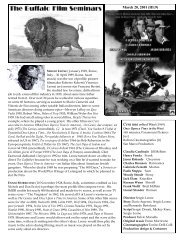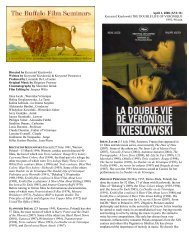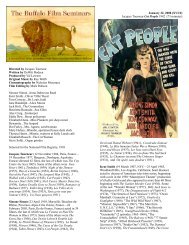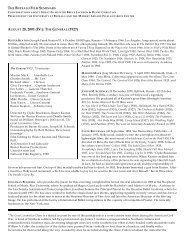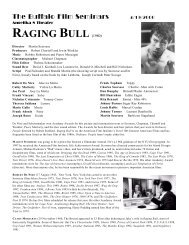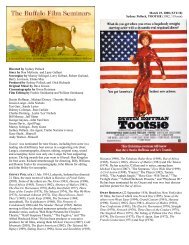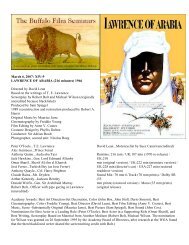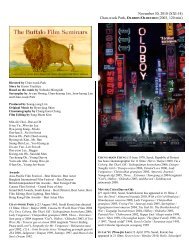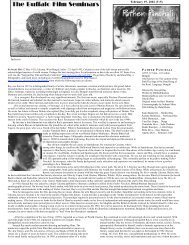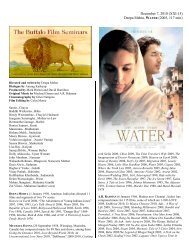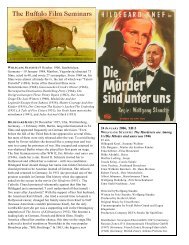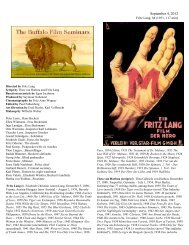You also want an ePaper? Increase the reach of your titles
YUMPU automatically turns print PDFs into web optimized ePapers that Google loves.
.<br />
September 4, 2001 (IV:2)<br />
Pandora’s <strong>Box</strong>/Die Büchse der Pandora<br />
1929,<br />
Louise Brooks ..Lulu<br />
Fritz Kortner..Dr. Peter Schön<br />
Francis Lederer....Alwa Schön<br />
Carl Goetz....Schigolch<br />
Krafft-Rasch ig....Rodrigo Q uast<br />
Alice R oberts....Countess Anna Geschwitz<br />
Gustav Diessl....Jack the Ripper<br />
Michael von Newlinsky....Marquis Casti-<br />
Piani<br />
Directed by Georg Wilhelm Pabst<br />
Written by Joseph Fleisler, Georg<br />
Wilhelm Pabst, Ladislaus Vajda, based<br />
on Frank Wedekind’s plays Der Erdgeist<br />
and Die Büchse der Pandora)<br />
Produced by Seymour Nebenzal<br />
Cinematography by Günther Krampf<br />
Production Company Nero-Film AG<br />
GEORG WILHELM PABST (27 August 1885, Raudnitz, Austria —29 May 1967,<br />
Vienna) directed 39 films. The first was Der Schatz 1923 (The Treasure), the last Durch<br />
die Wälder 1956 (Through the Forests and Through the Trees). Some of the others were<br />
Rosen für Bettina 1956 (Ballerina), Der Letzte Akt 1955 (Hitler: The Last Ten Days), La<br />
Conciencia acusa 1952, (Voice of Silence), Der Prozeß 1948 (The Trial), Paracelsus 1943,<br />
Jeunes filles en détresse 1939, Mademoiselle Docteur 1936, (Street of Shadows), White<br />
Hunter 1936, Don Quixote 1933, Kameradschaft 1931 (Comradeship), Die 3groschenoper<br />
1931 (The Threepenny Opera), Die Weiße Hölle vom Piz Palü 1929 (White Hell of Pitz<br />
Palu), Das Tagebuch einer Verlorenen 1929 (Diary of a Lost Girl), Abwege 1928<br />
(Crisis/Desire/The Devious Path), Die Liebe der Jeanne Ney 1927 (The Loves of Jeanne<br />
Ney/Lusts of the Flesh), Die Freudlose Gasse 1925 (Joyless Street/The Street of Sorrow).<br />
LOUISE BROOKS (Mary Louise Brooks, 14 November 1906, Cherryvale, Kansas,<br />
USA—8 August 1985, Rochester, New York) is the subject of two documentary films, Looking for Lulu 1998, written by her biographer Barry<br />
Paris, and Lulu in Berlin 1984, a fascinating interview, mostly about her work with Pabst, by documentary filmmaker Richard Leacock. She<br />
seems to have enjoyed work on her early films made at the Famous Players-Lasky studio in Astoria, Queens, but she hated Hollywood<br />
and, after working with Pabst, pretty much let her career lapse rather than go back there. Her last film was a small part in Overland Stage<br />
Raiders 1938, which featured the still-unknown John Wayne (he would become a star the following year with Stagecoach). During the 30s<br />
she supported herself working as a clerk in a New York department store, turning occasional tricks, dancing, and taking a few small film<br />
roles. In her later years, she was supported by one of her former lovers. Some of the films on which her reputation rests are Prix de beauté<br />
1930, Das Tagebuch einer Verlorenen, 1929, The Canary Murder Case 1929 (she was the canary and insisted that her costume have a removable<br />
tail so she could sit down between takes), Beggars of Life 1928, A Girl in Every Port 1928 and It's the Old Army Game 1926 . The most frequent<br />
complaint about her in Hollywood was that she read books on the set instead of exchanging gossip with the other actors. She wrote a<br />
biography—“Naked on My Goat”—but tossed the manuscript into the incinerator because she didn’t like it.<br />
FRITZ KORTNER (Fritz Nathan Kohn, 12 May 1892, Vienna,<br />
Austria—22 July 1970, Munich, Germany), one of Germany’s<br />
greatest actors, moved to London in the mid-30s after he became<br />
the subject of vicious attacks from the Nazis because he was<br />
Jewish. He then moved to Hollywood in 1941. He returned to<br />
Germany in 1949 to star in The Last Illusion. The film was a major<br />
success and he resumed his career there as actor, director, and<br />
writer. He appeared in about 50 films, the last as Shylock in a<br />
German made-for-tv film, Der Kaufmann von Venedig 1968 ; the<br />
first Das andere Ich 1918 . Some of the others were: Blaubart 1951<br />
(Bluebeard) 1951, The Vicious Circle 1948, Berlin Express 1948, The<br />
Brasher Doubloon 1947, The Razor's Edge 1946, The Hitler Gang 1944,<br />
The Strange Death of Adolf Hitler 1943, Abdul the Damned 1935, Der<br />
Mörder Dimitri Karamasoff 1931 (The Brothers Karamazov/The<br />
Murderer Dimitri Karamazov), Danton 1931, Dreyfus 1930,<br />
Somnambul 1929 (The Somnambulist), Orlacs Hände 1924, Die Brüder<br />
Karamasoff 1918 (The Brothers Karamazov).<br />
GÜNTHER KRAMPF (8 February 1899, Vienna, Austria—4 August<br />
1950, London) was one of Germany’s most important silent-era
cinematographers. His first film, Nosferatu 1922, is still shown<br />
regularly at film festivals and on cable tv. Some of his other films<br />
are The Franchise Affair 1950, This Was a Woman 1948, Meet Me at<br />
Dawn 1947, The Night Has Eyes 1942, Convoy 1940, The Outsider<br />
1940, The Ghoul 1934, Jew Suess 1934 (Power)(not to be confused<br />
with the 1940 Nazi propaganda film), Rome Express 1932, The<br />
Outsider 1931, Orlacs Hände 1924 (Hands of Orlac), and Der Verlorene<br />
Schuh 1923 (Cinderella).<br />
FRANK WEDEKIND (Benjamin Franklin Wedekind, 24 July 1864,<br />
Hannover, Hanover [now Germany]—9 March 1918, Munich,<br />
Germany). Dramatist, journalist and publicist. He worked on the<br />
staff of Simplicissimus. A forerunner of the expressionists, he<br />
employed grotesque fantasy and unconventional characters in<br />
order to attack the bourgeois ideals and hypocrisy of his society.<br />
Wedekind was particularly concerned with sexual themes,<br />
stressing the primacy of man's instincts. His plays include<br />
Frühlings Erwachen (1891, The Awakening of Spring), Der Erdgeist<br />
(1895, Earth Spirit), and Die Büchse der Pandora (1903, <strong>Pandora's</strong><br />
<strong>Box</strong>). Alban Berg compiled the libretto for his opera Lulu (1934)<br />
from the latter two. (From Columbia Electronic Library)<br />
PHILIP CARLI, pianist for tonight’s screening of The Big Parade, began<br />
accompanying silent films at the age of 13, with a solo piano<br />
performance for Lon Chaney’s 1923 version of The Hunchback of Notre<br />
Dame at his junior high school in California. He has toured extensively<br />
as a film accompanist throughout North America and Europe,<br />
performing at such venues as Lincoln Center and the Museum of<br />
Modern Art in New York, the National Gallery in Washington, DC, the<br />
Cinémathèque Québecoise in Montreal, the National Film Theatre in<br />
London, and the Berlin International Film Festival. He is the staff<br />
accompanist for the George Eastman House in Rochester, New York,<br />
and performs annually at several film festivals in the United States as<br />
well as at Le Giornate del Cinema Muto in Italy. He has recorded piano<br />
accompaniments to over fifty films for video release by the Library of<br />
Congress, a number of film and video companies, and for broadcast on<br />
the American Movie Classics and the Turner Classic Movies cable<br />
channels.<br />
The two best sources of information on Louise Brooks are Brooks’ Lulu in Hollywood (Knopf, NY 1982), seven essays about her film world<br />
experiences and opinions that originally appeared in Sight and Sound and other film journals, and Barry Paris’s Louise Brooks; A Biography<br />
(Knopf, NY 1989). Kevin Brownlow has a brief but informative interview with her in The Parade’s Gone By... (U. California Press, Berkeley and<br />
LA, 1968). There’s probably more about Brooks on the <strong>web</strong> than anyother silent star. The best is the one maintained by the Louise Brooks<br />
Society, www.pandorasbox.com. The <strong>site</strong> is full of great material about Brooks and her films; it’s got a good filmography and bibliography,<br />
scores of photos and production stills, all the right links and more.<br />
New Yorker editor William Shawn in his introduction to Lulu in Hollywood: “Louise Brooks is not only an actress who writes; she is a writer<br />
who acts. Long ago, she also danced. People who saw her dance say that she was a captivating dancer, and I am confident she was.<br />
Whatever she does, she is, indivisibly, an artist. In order to understand Louise Brooks, however, one first has to disentangle her from her<br />
most famous role: that of Lulu in G.W. Pabst’s 1929 silent film Pandora’s <strong>Box</strong>. There have been a host of Lulus, of course, since the German<br />
playwright Frank Wedekind created the character in his plays Earth Spirit and Pandora’s <strong>Box</strong>. A number of actresses have played the role<br />
on the stage. Since Alban Berg created his vocal, atonal Lulu in the opera of that name, a number of singers have sung the role. Yet it was<br />
Louise Brooks, in silence and out of her own person, who created the fundamental, the only Lulu. As the years have passed, the image of<br />
Louise Brooks as Lulu has persisted on the screen, and has haunted, and informed, all other performances.”<br />
LB from Lulu in Hollywood:<br />
In May, when the studio wanted me in order to start production<br />
of Beggars in Life, under the direction of William Wellman, it had<br />
to track me from Hollywood to New York and on to Miami, then<br />
to Havana, to Palm Beach, and finally, to Washington, where I<br />
was visiting George Marshall, the owner of the professional<br />
football team the Redskins. While waiting for the capture of a<br />
seemingly reluctant actress he had never met, Billy Wellman came<br />
to the unfortunate conclusion that since I did not follow the<br />
pattern of the actors who haunted the studio panting after film<br />
roles, I did not care about films at all. Because he didn’t know that<br />
sycophancy had no merit in the New York studio where I had<br />
begun my career, and because I was unaware that prudent<br />
Hollywood actors wooed producers, directors, and writers with<br />
flattering attention, a coldness was set up between us which<br />
neither of us could dispel. Nor did hard work on my part and a<br />
willingness to do dangerous stunts under his direction alter Billy’s<br />
conclusion. In 1932, at the bar of Tony’s Restaurant in New York,<br />
he asked, ‘Why did you always hate making pictures, Louise?’<br />
Those were the last words I ever heard him speak. Before that,<br />
this intricate man had offered me a part in The Public Enemy, then<br />
passed it on to Jean Harlow when I turned it down in order to<br />
make a trip to New York. Bewitched by his own success in<br />
Hollywood, he could not imagine my hating the place.”<br />
As a loner, I count as my two most precious rights those that allow me to choose the periods of my aloneness and allow me to choose the<br />
people with whom I will spend the periods of my not-aloneness. To a film star, on the hand, to be let alone for an instant is terrifying. It is<br />
the first signpost on the road to oblivion. Obviously, an actor cannot choose the people who whom he will work, or when or how he will<br />
work with them. He goes to work at a time specified by the studio. He spends his working day under the control not only of his director<br />
but also of the scriptwriters, the cameraman, the wardrobe department, and the publicity office. Since publicity is the lifeblood of stardom,<br />
without which a star will die, it is equally obvious that he must keep it flowing through his private life, which feeds the envy and curiosity<br />
that bring many people into theaters.<br />
For all actors know that truly natural acting is rejected by the audience. Although people are better equipped to judge acting than any<br />
other art, the hypocrisy of “sincerity” prevents them from admitting that they, too, are always acting some role of their own invention. To<br />
be a successful actor, then, it is necessary to add eccentricities and mystery to naturalness, so that the audience can admire and puzzle<br />
over something different from itself.
The tragedy of film history is that it is fabricated, falsified, by the very people who make film history. It is understandable that in the early<br />
years of film production, when nobody believed there was going to be any film history, most film magazines and books printed trash,<br />
aimed only at fulfilling the public’s wish to share a fairy-tale existence with its movie idols. But since about 1950 film has ben established as<br />
an art, and its history recognized as a serious matter. Yet film celebrities continue to cast themselves as stock types—nice or naughty girls,<br />
good or bad boys—whom their chroniclers spray with a shower of anecdotes.<br />
Frank Wedekind’s play Pandora’s <strong>Box</strong> opens with a prologue. Out<br />
of a circus tent steps the Animal Tamer, carrying in his left hand a<br />
whip and in his right hand a loaded revolved. “Walk in,” he says<br />
to the audience. “Walk into my menagerie!” The finest job of<br />
casting that G.W. Pabst ever did was casting himself as the<br />
director, the Animal Tamer of his film adaption of Wedekind’s<br />
“tragedy of monsters.” Never a sentimental trick did this whip<br />
hand permit the actors assembled to play his beasts. The revolver<br />
he shot straight into the heart of the audience. At the time<br />
Wedekind produced Pandora’s <strong>Box</strong>, in Berlin around the turn of<br />
the century, it was detested, condemned, and banned. It was<br />
declared to be “immoral and inartistic.” If in that period when the<br />
sacred pleasures of the ruling class were comparatively private, a<br />
play exposing them had called out the dogs of law, how much<br />
more savage would be the attack upon a film faithful to<br />
Wedekind’s text which was made in 1928 in Berlin, where the<br />
ruling class publicly flaunted its pleasures as a symbol of wealth<br />
and power. And since nobody truly knows what a director is<br />
doing till he is done, nobody who was connected with the film<br />
dreamed that Pabst was risking commercial failure with the story<br />
of an “immoral” prostitute who wasn’t crazy about her work and<br />
was surround by the “inartistic” ugliness of raw bestiality. Only<br />
five years earlier the famous Danish actress Asta Nielsen had<br />
condensed Wedekind’s play into the film Loulou. There was no<br />
lesbianism in it, no incest. Loulou, the man-eater devoured her sex<br />
victims—Dr. Goll, Schwarz, and Schön—and then dropped dead<br />
in an acute attack of indigestion. This kind of film, with Pabst<br />
improvements, was what audiences<br />
were prepared for. Set upon<br />
making their disillusionment<br />
inescapable, hoping to avoid even<br />
any duplication of the straight bob<br />
and bangs that Nielsen had<br />
worn as Loulou, Mr. Pabst tested me<br />
with my hair curled. But<br />
after seeing the test he gave up this<br />
point and left me with my<br />
shiny black helmet, except for one<br />
curled sequence on the<br />
gambling ship.<br />
How Pabst determined that I was his unaffected Lulu, with the childish simpleness of vice, was part of a<br />
mysterious alliance that seemed to exist between us even before we met. He knew nothing more of me than<br />
an unimportant part he saw me play in the Howard Hawks film A Girl in Every Port (1928). I had never heard<br />
of him, and had no idea he had made unsuccessful negotiations to borrow me from Paramount until I was called to the front office on the<br />
option day of my contract. My salary wasn’t going to be increased. B.P. Schulberg told me that I could stay on at my old salary or quit. It<br />
was the time of the switchover to talkies, and studios were taking ugly advantage of this fact to cut contract players’ salaries. Refusing to<br />
take what amounted to a cut, I quit Paramount. Almost as an afterthought, Schulberg told me about the Pabst offer, which I was now free<br />
to accept. I said I would accept it, and he sent off a cable to Pabst. All this took about ten minutes, and I left Schulberg somewhat dazed by<br />
my composure and my quick decisions.<br />
Not long ago, after seeing Pandora’s <strong>Box</strong> at Eastman House, a<br />
priest said to me, “How did you feel, playing—that girl?<br />
“Feel? I felt fine? It all seemed perfectly normal to me.”<br />
Seeing him start with distaste and disbelief, and unwilling to be<br />
mistaken for one of those women who like to shock priests with<br />
sensational confessions, I went on to prove the truth of Lulu’s<br />
world by telling him of my own experience in the 1925 Ziegfeld<br />
Follies, when my best friend was a lesbian and I knew two<br />
millionaire publishers who, much like Schön in the film, backed<br />
shows to keep themselves well supplied with Lulus. But the priest<br />
rejected my reality exactly as Berlin had rejected its reality when<br />
we made Pandora’s <strong>Box</strong> and sex was the business of the town. At<br />
the Eden Hotel, where I lived in Berlin, the café bar was lined<br />
with the higher-priced trollops. The economy girls walked the<br />
street outside. On the corner stood the girls in boots, advertising<br />
flagellation. Actors’ agents pimped for the ladies in luxury<br />
apartments in the Bavarian Quarter. Race-track touts at the<br />
Hippegarten arranged orgies for groups of sportsmen. The<br />
nightclub Eldorado displayed an enticing line of homosexuals<br />
dressed as women. At the Maly, there was a choice of feminine or<br />
collar-and-tie lesbians. Collective lust roared unashamed at the<br />
theatre. In the revue Chocolate Kiddies, when Josephine Baker<br />
appeared naked except for a<br />
girdle of bananas, it was<br />
precisely as<br />
Lulu’s stage entrance was<br />
described by Wedekind:<br />
“They rage<br />
there as in a menagerie<br />
when the meat appears at<br />
the cage.”<br />
Every actor has a natural animosity toward every other actor, present or absent, living or dead. Most<br />
Hollywood directors did not understand that, any more than they understood why an actor might<br />
be tempted to withhold the rapt devotion to the master which they considered essential to their<br />
position of command. When I went to Berlin to film Pandora’s <strong>Box</strong>, what an exqui<strong>site</strong> release, what a<br />
revelation of the art of direction, was the Pabst spirit on the set! He actually encouraged actors’ disposition to hate and back away from<br />
each other, and thus preserved their energy for the camera; and when the actors were not in use, his ego did not command them to sit up<br />
and bark at the sight of him. The behavior of Fritz Kortner was a perfect example of how Pabst used an actor’s true feelings to add depth<br />
and breadth and power to his performance. Kortner hated me. After each scene with me, he would pound off the set and go to his<br />
dressing room. Pabst himself, wearing his most private smile, would go there to coax him back for the next scene. In the role of Dr. Schön,
Kortner had feelings for me (or for the character Lulu) that combined sexual passion with an equally passionate desire to destroy me. One<br />
sequence gave him an opportunity to shake me with such violence that he left ten black-and-blue fingerprints on my arms. Both he and<br />
Pabst were well pleased with that scene, because Pabst’s feelings for me, like Kortner’s were not unlike those of Schön for Lulu. I think<br />
that in the two films Pabst made with me—Pandora’s <strong>Box</strong> and Diary of a Lost Girl—he was conducting an investigation into his relations<br />
with women, with the object of conquering any passion that interfered with his passion for his work. He was not aroused by sexual love,<br />
which he dismissed as an enervating myth. It was sexual hate that engrossed his whole being with its flaming reality.<br />
Unlike most directors, Pabst had no catalogue of characters, with stock emotional responses. D.W. Griffith required giggling fits from all<br />
sexually excited virgins. If Pabst had ever shot a scene showing a virgin giggling, it would have been because someone was tickling her. It<br />
was the stimulus that concerned him. If he got that right, the actor’s emotional reaction would be like life itself—often strange and<br />
unsatisfactory to an audience that was used to settled acting conventions.<br />
In an effort to be funny, old actors and directors have spread the false belief that any clownish thing coming to mind could be said in front<br />
of the camera in silent films. They forget that the title writer had to match his work to the actors’ speech. I remember late one night<br />
wandering into the Beverly Wilshire suite of Ralph Spence, a title-writer, where he sat gloomily amidst cans of film, cartons of stale<br />
Chinese food, and empty whiskey bottles. He was trying to fix up an unfunny Beery and Hatton comedy, and no comic line he invented<br />
would fit the lip action. Silent-film fans were excellent lip-readers and often complained at the box office about the cowboy cussing<br />
furiously as he tried to mount his horse.<br />
...a truly great director such as G.W. Pabst holds the camera on the actors’ eyes in every vital scene. He said, “The audience must see it in<br />
the actors’ eyes.” In his 1926 film, Secrets of a Soul, he sent the actor playing a psychiatrist to take a course in psychoanalysis so he could see<br />
it in his eyes. Pabst’s genius lay in getting to the heart of a person, banishing fear, and releasing the clean impact of personality which jolts<br />
an audience to life.<br />
With gross overconfidence in my rights and power, I at first defied Pabst with arrogance. Pabst chose all my costumes with care, but in<br />
scenes motivated by sexual hate he chose them as much for their tactile as for their visual seductiveness. He wanted the actors working<br />
with me to feel my flesh under a dancing costume, a blouse and skirt, a nightgown. The morning of the<br />
sequence in which I was to go from my bath into a love scene with Franz Lederer, I came on the set wrapped<br />
in a gorgeous negligee of painted yellow silk. Carrying the peignoir I refused to wear, Josifine approached<br />
Mr. Pabst to receive the lash. Hers was the responsibility for seeing that I obeyed his orders, and he answered<br />
her excuses with a stern rebuke. Then he turned it to me.<br />
“Loueess,you must wear the peignoir, and be naked under it.”<br />
“Why? I hate that bathrobe,” I said. “Who will know that I am naked under that big, woolly white<br />
bathrobe?”<br />
”Lederer,” he said.<br />
Stunned by such a reasonable argument, I retired, without another word, to the bathroom set with Josifine<br />
and changed into the peignoir.<br />
Mr. Pabst’s perfect costume sense symbolized Lulu’s character and her destruction. There is not a single spot of blood on the pure-white<br />
bridal satin in which she kills her husband. Making love to her wearing the clean white peignoir, Alva asks, “Do you love me, Lulu?” “I?<br />
Never a soul!” It is in the worn and filthy garments of streetwalker that she feels passion for the first time—comes to life so that she may<br />
die. When she picks up Jack the Ripper on the foggy London street and he tells her he had no money to pay her, she says, “Never mind. I<br />
like you.” It is Christmas Eve, and she is about to receive the gift that had been her dream since childhood. Death by a sexual maniac.<br />
In Hollywood, I was a pretty flibbertigibbet whose charm for the executive department decreased with every increase in her fan mail. In<br />
Berlin, I stepped onto the station platform to meet Pabst and became an actress. ...To other people surrounding him, he would talk<br />
endlessly in that watchful way of his, smiling, intense; speaking quietly, with his wonderful, hissing precision.<br />
But to me he might speak never a word all morning, and then at lunch turn suddenly and say, “Louess,<br />
tomorrow morning you must be ready to do a big fight scene with Kortner,” or “This afternoon, in the first<br />
scene, you are going to cry.” That was how he directed me. With an intelligent actor, he would sit in exhaustive<br />
explanation; with an old ham, he would speak the language of the theatre. But in my case, by some magic, he<br />
would saturate me with one clear emotion and turn me loose. And it was the same with the plot. Pabst never<br />
strained my mind with anything not pertinent to the immediate action.<br />
from LB’s interview in Kevin Brownlow, The Parade’s Gone By...<br />
You know what makes an actor great to work with? Timing. You don’t have to feel anything. It’s like dancing<br />
with a perfect dancing partner. Osgood Perkins would give you a line so that you would react perfectly. It was<br />
timing—because emotion means nothing.<br />
Look at Adolphe Menjou. He never felt anything. He used to say, “Now I do Lubitsch number one,” “Now I do Lubitsch number two.”<br />
And that’s exactly what he did. You felt nothing, working with him, and yet to see him on the screen—he was a great actor.<br />
A director works fast who knows everything ahead of time. He sees the picture finished, whole, cut, titled. Pabst would take one shot,<br />
and—that was it. I remember I was going to do my famous Follies-girl walk across the stage in the theater scene of Pandora’s <strong>Box</strong>. I’d<br />
planned it all out. I took four steps on stage and Pabst said “Cut.” That was the end of it. I had give him all he wanted.
When I worked in night clubs, and in the theater, I knew all the real gangsters. Men like Capone. They were the most disgusting, idiotic<br />
boors. But, oddly enough, they had one great talent. During Prohibition, they owned a lot of nightclubs and they would hire people for<br />
these clubs that nobody else would have. A girl like Helen Morgan, for instance; nobody wanted<br />
her. She had a delicate little voice, she had very long legs, she had a large bosom, which wasn’t<br />
fashionable then; she wasn’t very animated, and she sat on the piano and wouldn’t use a<br />
microphone. The gangsters loved her. They put her in a night club called The Backstage, and all of a<br />
sudden Zigfield “discovered” her.<br />
Wallace Beery used to scheme all day to figure out ways to get my back to camera in two-shots. Billy<br />
Wellman said to me, “Don’t let him do that to you.” I said, “I don’t give a damn what he does.<br />
You’re the director. If you don’t want him to back me up, you tell him.” The result was that he’d<br />
have to take close-ups of me to get my face in the pictures. So I’d be in a close-up while Wally would<br />
be in a two-shot!<br />
Looking through an old dictionary with the flyleaves pasted with quotes form Goethe, I came upon<br />
this one: “The novel [film] is a subjective epic composition in which the author begs leave to treat<br />
the world according to his point of view. It is only a question, therefore, whether he has a point of<br />
view. The rest will take care of itself.”<br />
In a 1972 letter to her brother Theo: “How I have existed fills me with horror. For I failed in<br />
everything—spelling, arithmetic, riding, swimming, tenis, golf, dancing, singing acting; wife,<br />
mistress, whore, friend. Even cooking. And I do not excuse myself with the usual escape of ‘not trying.’ I tried with all my heart.”<br />
Louise to Leacock in 1974: “You are the first person to make me really laugh—which I really adore—since I banned Jimmie Card in 1963."<br />
LB: I have a gift for enraging people.<br />
Howard Hawkes: I wanted a new type. I hired Louise Brooks because she’s so very sure of herself, she’s very<br />
analytical, she’s very feminine–but she’s damn good and sure she’s going to<br />
do what she wants to do. I could use her today [1967]. She was way ahead of<br />
her time. And she’s a rebel. I like her, you know. I like rebels. I like people you<br />
can look at and remember who they are.<br />
LB: I never try to feel sexy. . . .The people who try hardest to be sexy only fool<br />
other fools.<br />
Marlene Dietrich: Imagine Pabst choosing Louise Brooks for Lulu when he<br />
could have had me!<br />
Michelle pfeiffer as Louise<br />
Henri Langlois: There is no Garbo! There is no Dietrich! There is only Louise<br />
Brooks!<br />
LB: I just didn’t fit into the Hollywood scheme at all. I was neither a fluffy heroine, nor a wicked vamp, nor a<br />
woman of the world. I just didn’t fit into any category. I just didn’t interest them because I couldn’t be typed.<br />
Madonna as Louise<br />
LB: In writing the history of a life, I believe absolutely that the reader cannot understand the character and deeds of the subject unless he<br />
is given an understanding of that person’s sexual loves and hates and conflicts. It is the only way the reader can make sense out of<br />
innumerable apparently senseless actions. . . .I too am unwilling to write the sexual truth that would make my life worth reading. I cannot<br />
unbuckle the Bible Belt. That is why I will never write my memoirs.<br />
LB: If I ever bore you it’ll be with a knife.<br />
Join us next Tuesday, September 11 th , for Edward G. Robinson as Rico Bandello in the first great gangster movie,<br />
Mervyn LeRoy’s Little Caesar (1930). Screeching tires, the rattle of machine guns! Soundtracks were made for this!<br />
Email Diane engdc@acsu.buffalo.edu email Bruce bjackson@buffalo.edu visit our <strong>web</strong><strong>site</strong> www.buffalofilmseminars.com<br />
THE BUFFALO FILM SEMINARS ARE PRESENTED BY THE MARKET ARCADE FILM & ARTS CENTER &



